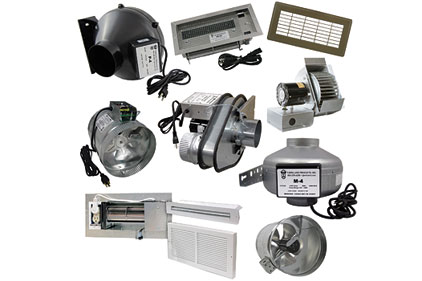In-duct booster fans don’t generate additional cfm. They work by boosting the pressure so that more airflow reaches the area that needs it. Typically these areas are the furthest distance from the air handler, or where the duct size is too small.
Booster fans are best installed at or beyond the point in the duct where airflow drops below its desired performance, not near the air handler where airflow is greatest.
Residential Uses
Residentially, in-duct booster fans are also used when room additions require tapping into existing ducts that were not originally designed to be extended. They can also be used on return-air ducts to increase air exchange in tight rooms when doors are closed, or where return-air ducting is restricting flow back to the air handler.
The most popular residential booster fan sizes are 6- and 8-inch round. Most booster fans in these sizes are designed for connection to metal duct with a taper on the leading edge. A 6-inch booster fan with special connectors for flex duct is also available.
Another type of booster fan fits into the boot and replaces the existing register in 4- by 10-inch and 4- by 12-inch boots. This design is popular in finished construction, where there is no practical access to ducts. Economy models of these register boosters use small prop fans with a plastic housing and grille; deluxe models feature a tangential (cross-flow) blower with a metal housing and floor grille.
Yet another way to get additional conditioned air to a room is to use a transfer fan to move air from an adjacent space. Both room-to-room or level-to-level transfer fans are available. These fans are activated by a separate thermostat or wall switch.
Commercial Uses
Commercial applications generally require larger diameter connections and higher cfm and pressure. Models are available through 16 inches for connection to round metal duct.
Activating booster fans to operate in tandem with a central air handler is typically done using a pressure switch to sense positive pressure when the air handler is in operation. Some residential booster fans include a built-in pressure sensor. Using temperature sensors to activate the booster fan is another option, but the drift associated with cheaper snap-action thermostats can cause erratic booster fan operation.
Since most duct fans are self-contained within a section of duct, they are easy to use for a variety of air supply or exhaust applications, with typical duct fans being rated for up to 140°F air. Common exhaust applications include bathrooms, greenhouses, and radon mitigation.
Special booster fans are also made for helping long or convoluted residential clothes dryer duct runs. They decrease drying times and lint buildup by increasing the exhaust velocity. The most popular models feature automatic operation. For commercial dryer applications, some pressure controllers can automatically modulate the fan speed. When selecting a booster fan, consider the duct size, cfm, static pressure and activation methodology that best matches your application. Duct fan manufacturers are a good resource for application and installation advice.
Publication date: 09/26/2011









